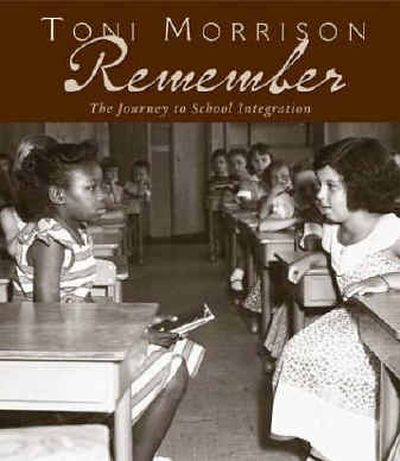Book looks at children and integration

The most famous photographs of school integration are images of hate.
They show angry whites jeering, spitting and threatening young, wide-eyed black students who needed the protection of soldiers and federal marshals to go to public schools.
But the photo on the cover of “Remember: The Journey to School Integration” by Toni Morrison (Houghton Mifflin, 80 pages, $18) is ambiguous.
The picture was taken in September 1954 on the first day of school in Fort Meyer, Va., after the Supreme Court declared segregated schools unconstitutional.
It shows two girls in dresses at their classroom desks staring at each other. The girl on the left, the one in saddle shoes, is black and looks uncertain.
The girl on the right, in patent leather shoes, is white and looks as if she’s about to say something.
When Andrea Davis Pinkney, publisher of Houghton Mifflin Children’s Books, proposed to Morrison that she write a children’s book about the struggle to integrate schools, that was the first photograph she sent.
“I kept staring at it and wondering, ‘What were those girls thinking?’ ” says Pinkney, who has written several children’s books.
Her idea was to use black-and-white archival photos and ask Morrison, the Nobel Prize-winning novelist, to imagine the dialogue and emotions of children photographed as a part of history 50 years ago.
After initial hesitation — “I didn’t want to patronize the children,” Morrison says — she agreed. She imagined the black girl on the cover asking two questions: “I think she likes me, but how can I tell? What will I do if she hates me?”
Another photo in the book shows three white teenagers in Clinton, Tenn., protesting the integration of their high school with signs proclaiming, “WE WON”T GO TO SCHOOL WITH NEGROES.”
Again, Morrison imagines a question: “I don’t know. My buddies talked me into this. They said it would be fun. It’s not, but these guys are my friends and friends are more important than strangers. Even if they’re wrong. Aren’t they?”
Not all of the book’s 52 photographs are from the South. In Hillsboro, Ore., black students protested segregated schools in 1956. In Englewood, N.J., white parents organized a school boycott against desegregation in 1962.
In the book’s introduction, Morrison, 73, who attended integrated schools in Lorain, Ohio, asks her young readers: “Why offer memories you do not have? Remembering can be painful, even frightening. But it can also swell your heart and open your mind.”
Pinkney says she knew there would be several adult books to mark Monday’s 50th anniversary of the Supreme Court’s landmark “Brown v. Board of Education” decision .
Charles Clotfelter’s “After Brown” (Princeton University Press, $24.95) and Sheryll Cashin’s “The Failures of Integration” (PublicAffairs, $26) both cite evidence that the country is more segregated than ever.
Pinkney says she wanted a book that would serve as “a springboard for children and parents and teachers to discuss a struggle that’s changed but that’s still going on.”
Many of the children in the photos in “Remember” would be about 60 years old by now. None are identified. Did Morrison wonder about their reactions to her invented dialogue?
“No, that would have stopped me in my tracks,” she says. “I just hope they don’t mind.”